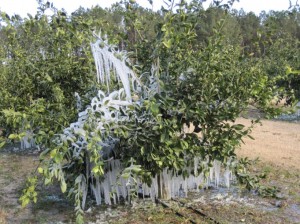On the night of November 13th, a mild freeze of 30°F occured in parts of Northwest Florida. Don’t be caught without a citrus protection plan !
How cold does it have to get before citrus in Northwest Florida needs to be protected? A concrete answer to this question does not exist. Growers and home gardeners alike must consider several factors including type of citrus grown and the location of the citrus.
Below are a few quick facts to assist growers and home gardeners in determining whether to protect or not to protect their citrus:
- Certain citrus trees such as lime, pomelo, grapefruit, sweet orange, lemon and citron will definitely need protection or need to be moved into a sheltered area. Individuals that grow these types on a consistent basis either wrap their trees with protective covers each season or grow them in containers and move them into greenhouses.
- The meyer lemon, which is in reality a lemon-sweet orange hybrid, is a tree that was introduced to the united states in 1908. Mature dormant meyer lemons can be hardy down to 20°F, with fruit hardy to 26°F. Immature trees, or those that have not reached dormancy, should be protected. Covers made of cloth should be large enough to touch the ground so that heat from the soil can help keep the tree warm.
- Generally, satsuma are cold tolerant down to 15° F, but young trees or trees yet to achieve dormancy are usually only tolerant to 26°F. Fruit should not sustain damage from freezing temperatures above 25°F. Extreme winds sometimes make the effects of freeze events worse, so it is always better to err on the side of protection if the trees are planted in an exposed site.
- Kumquats are the most cold tolerant citrus type grown in Northwest Florida, so protection is not required unless freeze events reach 20°F.
Additional facts to assist the grower or home gardener with citrus protection:
- Plant trees on a south-facing slope, south of windbreaks, on the south side of a structure or under a light canopy if possible. South facing slopes block harmful cold winds. Structures offer radiant heat which aids in the protection of citrus trees. Additionally, light over-story pine canopies allow sufficient sunlight through while reducing frost damage.
- Wrap the trunk with commercial tree wrap or mound soil around the base of the tree up to 2 feet. This will protect the graft of the young tree. Thus, if the branches freeze the graft union will be protected.
- Cover the tree with a cloth sheet or blanket. For additional protection, large bulb Christmas lights can be placed around the branches of the tree. This will increase the temperature under the cover by several degrees. Be sure to use outdoor lights and outdoor extension cords to avoid the potential of fire.
- Water citrus trees. Well watered trees have increased cold hardiness. Do not over-water. If the ground is moist, it is not necessary to water.
- Frames may be installed around young trees to hold the cover. This option keeps the blanket or sheet from weighing down the branches.
- For large production areas, micro-irrigation is an option. This practice will protect citrus trees up to 5 feet, but must be running throughout the entire freeze event. For additional information read this publication on micro-sprinkler irrigation.
- Always remember to remove cold protection once the temperature rises so that the trees do not overheat.
- Do not cover trees with plastic tarp, these will not protect the tree and can “cook” the tree once the sun comes out.
For additional information, contact your local extension office.
Latest posts by Matthew Orwat (see all)
- Woodland Pinkroot Adds Vibrant Color to Spring Landscapes - April 27, 2023
- Easy Care Roses for the Gulf South - April 20, 2023
- Herb Gardening: When Oregano is Flavorless - March 9, 2023

